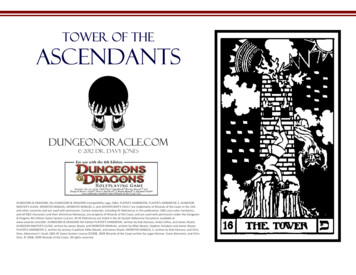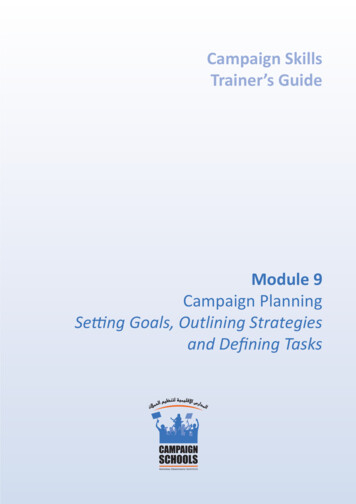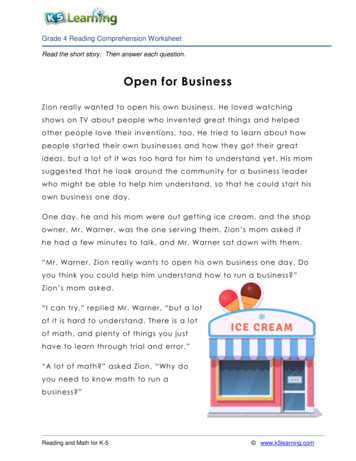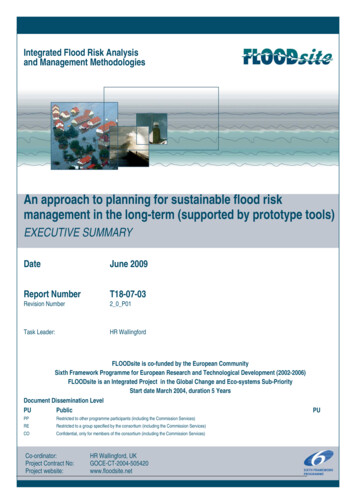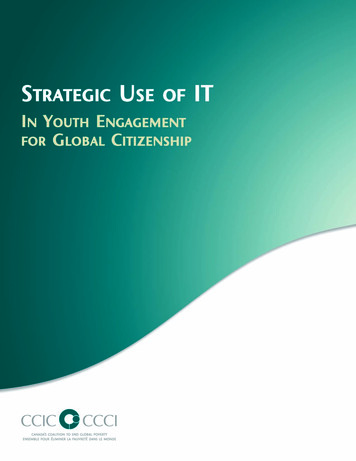
Transcription
AcknowledgementsThis document was prepared by Karine Girard of the Canadian Council of International Co-operation (CCIC). CCIC wouldlike to thank its members for their contribution to this article, especially Amélie Carpentier and Francois Gloutnay(Development and Peace), Marie-Hélène Forest and Chloé Gaudet (CWY), Marie Houde (Oxfam Quebec), Kris OrantesMigoya (OCIC), Fiona Talbot-Strong (CCI), Alan Webb (VSO), and Amber Aleman (Oxfam Canada). A special thanks toMaja Andjelkovic, Heather Creech (IISD), Rachel Dhawan and Ilona Dougherty (Apathy is Boring), Kimia Ghomeshi andLaura Kenyon (TakingITGlobal), Alejandro Gomez and Eric Squair (MPH), Richard Graves (It’s Getting Hot in Here), DarenMcLean (QSTV), Kevin Millsip (CYH), Christina Porte (EYA), and Caroline Tagny (Alternatives).The Canadian Council for International Co-operation (CCIC) gratefully acknowledges the financial support provided forthis document by the Canadian Partnerships Program of the International Development Research Centre (IDRC) and theCanadian International Development Agency (CIDA).All or part of this document may be reproduced and used for nonprofit purposes, provided that CCIC is credited as thesource. Use of any part of this document for commercial purposes is forbidden without prior written permission fromCCIC.For additional information, contact:Organizational Development teamCanadian Council for International Co-operation (CCIC)1 Nicholas Street, Suite 300, Ottawa, Ontario K1N 7B7613-241-7007 info@ccic.ca www.ccic.caStrategic Use of IT in Youth Engagement for Global Citizenship.Also published in French as: L’utilisation stratégique des TIC en engagement jeunesse pour une citoyenneté mondialeAll rights reserved. Canadian Council for International Co-operation 2008
Table of ContentI.The Strategic Use of IT in Youth Engagement1. Youth expectations and engagement2. IT for Youth Engagement3. A few examples of IT usea) Publishing informationb) Communicating with supportersc) Mobilizing and facilitating actiond) Collaboratione) Training and research4. Toward an effective strategyII.A few factors to consider when developing an IT strategy1.2.3.4.5.6.7.8.III.Keep a youthful appearanceReach out to young people (online)Reach out to young people (off-line)Ensure that the technology is not exclusiveTake steps to keep the technology lively and youthful!Use resources as effectively as possibleCarefully monitor the content . or foster dialogue?In conclusion Innovative practices1.2.3.4.5.6.7.CWY Recruitment CampaignGet Your Vote On CampaignMake Poverty History E-CampaigningVideo contest by Quantumshift.tvWeb image of Apathy is BoringOCIC’s Global Citizens ForumAlternatives interns’ blogIV.Glossary of technologiesV.Youth engagement and appropriate technology - A quick reference grid
I. The Strategic Use of Information Technologies in Youth Engagementfor Global CitizenshipInformation technologies (IT) are becoming essential components of public engagement strategies, especially whenyouth are concerned. Young people are among the most frequent users of information technologies. Most of them have1turned away from the mass media and primarily look to the Internet or alternative sources for their information andmany of them benefit from virtual spaces to socialize. For these and other reasons, civil society organizations (CSO) inCanada need to begin thinking more seriously about the use of IT to engage youth in issues of human rights, globalpoverty, and social and environmental justice.The success of TakingITGlobal, an online, international platform used by over 180,000 young people from 260 countriesillustrates both the potential of IT to reach young people and the demand for these kinds of initiatives as a means offinding information, talking together and engaging. Although it would be misguided to assume that everyone under theage of 30 is a technological whiz, youth interest in new technologies is beyond doubt.2The member organizations of the Canadian Council for International Cooperation (CCIC) acknowledge the importanceof exploring the options offered by IT in relation to public engagement. It might be true that youth use Facebook andMySpace but does that mean that CSOs should jump on the bandwagon? Or should practitioners learn about whatmakes these networks successful and use IT more strategically in our youth engagement efforts and, by doing so,respond to their expectations? This article is intended as a resource to help stakeholders involved in youth engagementexplore these questions, develop an effective strategy and select the right technologies for achieving their objectives.1. Youth expectations and engagementYoung people are not a one-dimensional entity. Their diversity cannot be overlooked. However, an overview of theliterature on youth engagement reveals a few of their common expectations in relation to engagement. First of all, they3want to socialize and be with friends. They want networks that make it easy for them to join in. Moreover, some youth4claim that they might consider getting involved if they were approached in a personalized way.Their motivation also relates to their interest in learning or developing skills and the need to improve their employability.For them, social engagement is a means of exploring their strengths. Young people engage, but in return, they expect5opportunities for personal, social and work-related growth. They want to play a meaningful role and take on newresponsibilities, rather than do menial tasks "for a good cause."Of course, youth do join movements or organizations because they care about the issues and values being championed.However, they sometimes have difficulty to identify with the approaches used by some organizations, especially if67governance structures seem restrictive. They want to be considered full partners in initiatives. In other words, they1MacKinnon, Mary Pat; Sonia Pitre, and Judy Watling, Lost in Translation: (Mis)Understanding Youth Engagement, Canadian PolicyResearch Networks, October 2007, available at http://www.cprn.org.2The Canadian Council for International Co-operation is a coalition of Canadian voluntary sector organizations working globally toachieve sustainable human development. CCIC seeks to end global poverty, and to promote social justice and human dignity for all.3Raynes-Goldie, Kate and Luke Walker. “Our Space: Online Civic Engagement Tools for Youth”. Civic Life Online: Learning HowDigital Media Can Engage Youh. Edited by W. Lance Bennett, Cambridge, MA: The MIT Press. 2008. Pages 161–1884Barnard, Robert, Denise Andrea Campbell and Shelley Smith, Citizen Re:Generation - Understanding Active Citizen Engagement AmongCanada’s Information Age Generations, D-Code, 2003, available at http://www.d-code.com5Thibault, André ; Patrice Albertus and Julie Fortier, Rendre compte et soutenir l’action bénévole des jeunes, Canadian Policy ResearchNetworks, August 2007, available at http://www.cprn.org.6Thibault, André ; Patrice Albertus and Julie Fortier, Rendre compte et soutenir l’action bénévole des jeunes, Canadian Policy ResearchNetworks, August 2007, available at http://www.cprn.org.7Apathy is Boring, Youth friendly guide to intergenerational decision making, 2004, available at http://www.youthfriendly.com.2
want to be consulted and to participate at every stage, from identifying objectives to developing and implementingstrategies and activities.The participatory reflex of young people has grown with their increasingly frequent use of new information and8communication technologies. Taking the interactive capabilities of these technologies as our cue, we should perhapsrethink our strategies in order to meet the expectations of young people and generate longer-lasting, meaningfulengagement.2. IT for Youth EngagementInternet technologies offer many opportunities for dialogue and interaction. The more familiar they become with theseforms of involvement, the more young people - and the general public - have come to appreciate them. Youth want9opportunities to become more actively involved in campaigns. Whether by allowing users to contribute to developinginformation, sharing ideas with other users or simply stating their opinion through a survey, IT encourages thought andgenerates new knowledge. This thought-based involvement can help young people realize their ability to influence10society and therefore, engage over the long term.For members of civil society involved in public engagement, the challenge is to find creative ways to use IT that makeyoung people see themselves as forces for social change. Could we capitalize on their skill with social networking sitesand hand over control to them in promoting CSO activities? Should we create video and radio production workshops togive them training opportunities while exploring social issues? Or should we use networking technologies to supportgroup efforts to find solutions to genuine development issues? Information technologies may open many roads leadingto engagement but their various forms are worth exploring before deciding which are best suited to the objectives andresources of organizations and the expectations of young people.3. A few examples of IT useAbove and beyond Web 1.0 and static sites, new information and communication technologies are tools for engagingthe public online and off-line. These technologies can be used to interest young people in many aspects of NGO workand later, to support their own initiatives. Below are various examples of IT grouped according to the function they canserve (For an explanation of the technologies mentioned, refer to the Glossary.)a) Publishing informationEngaging the public is first and foremost a matter of relating public awareness about social issues to inspiredaction (or vice versa!). To achieve this requires producing and disseminating relevant and multi-facetedinformation. Online publication is especially useful considering that young people primarily get their information11from the Web or other alternative information sources. Apart from the possible savings in printing cost and theimmediate access to timely information, IT encourages public collaboration in developing information.In the era of Web 2.0, information production is no longer the exclusive domain of organizational staff. Anyonewho supports a cause may now contribute to producing information through blogs, wikis, video sharing sites8Barnard, Robert, Denise Andrea Campbell and Shelley Smith, Citizen Re:Generation - Understanding Active Citizen Engagement AmongCanada’s Information Age Generations, D-Code, 2003, available at http://www.d-code.com.9Jillaine Smith, Martin Kearns and Allison Fine, Power to the edges: Trends and Opportunities in Online Civic Engagement, 2005,available at http://www.pacefunders.org.10Derek Tannis, « Reaching the “Nexters”: Youth Participation and the Strategic Application of Technology in the Non-Profit Sector»,2005, available at http://www.usask.ca11MacKinnon, Mary Pat; Sonia Pitre, and Judy Watling, Lost in Translation: (Mis)Understanding Youth Engagement, Canadian PolicyResearch Networks, October 2007, available at http://www.cprn.org.3
and other forms of social media. It therefore offers them an opportunity to share their ideas and actions, toenlist the media and political decision makers, and in turn become forces of public engagement. The blogdeveloped by the Canadian youth delegation for the Bali summit is an excellent example of an initiative thatmanaged to generate interest and engagement among young people on climate change issues.b) Communicating with supportersNaturally, IT influences the means used to communicate with an organization's members and supporters. It isnow possible to reach a large number of people quickly and at little cost via email, text messaging or socialnetworking sites. One example that immediately comes to mind is the electronic newsletter, already a classic,that helps promote activities, campaigns and fundraising efforts. Based in Montreal, Club 2/3 was able to adaptand enliven its newsletter for a young audience by creating les Échos C2T. Viral dissemination of emailmessages also expands their potential reach. For Canada World Youth, this avenue was explored during a viralrecruitment campaign for exchange programs. The strategy was used to reach a targeted population whiletaking advantage of the word-of-mouth phenomenon.IT also fosters consultation and feedback. By asking the public to respond to initiatives - or communicate itsown - we can expand the depth of public engagement while measuring the impact of efforts made. Forexample, Fair Trade Manitoba generated active public involvement in its One-Month Challenge through aweekly electronic survey which also helped to evaluate the impact of their campaign.c) Mobilizing and facilitating actionIT is playing an increasingly important role in organizing group action and engaging popular support.Occasional calls for action sent by email are one example of a strategy effective with young people. By callingon their participation at specific times in response to specific circumstances participants can assess the impactof their involvement and gain a sense of belonging to a movement. Signing online petitions and cards can alsolead to long-term engagement. By asking the public to sign an online statement for its campaign in support ofuniversal access to public services, Oxfam Canada is able to obtain contact information for those whoparticipated. This makes it possible to develop a long-term relationship by sending out calls to action.Wireless telephone and text messaging are also used more and more often for engagement purposes. CheckYour Head in Vancouver experimented with this technology during one initiative designed to encourage youthto vote. Short texts containing information and invitations to certain election campaign-related eventsstrengthened interest among participants in the democratic process.d) Collaboration12In a recent compilation of good practices in youth engagement, Amnesty International raised an importantpoint: youth are extremely busy! Between school, work, recreation and family, it can sometimes be difficult forthem to find the time to become engaged. Networked technologies facilitate meeting planning and taskcoordination, and offer new opportunities for collaborating by overcoming the obstacles of distance, time andschedules. It can even lead to online volunteering. This approach was adopted by some organizations, asillustrated in a report available at Techsoup.org.IT can be used to break down the walls of isolation and creates ties among marginalized sharing similarexperiences, and provide them with the support and encouragement they need to take action against injustices12Amnesty International. Youth – Activism – Engagement – Participation: Good practices and essential strategies for impact. 2006.Available at http://rights.amnesty.org.4
they encounter in their lives and in the world around them. It also helps build bridges between highly divergentrealities: interaction and discussion using IT can be a first step toward creating a sense of solidarity with globalissues. Sharing personal stories is an effective method for stimulating social engagement. For example, Changefor Children, based in Alberta, used video conferencing to put young Canadians in touch with young people inNicaragua. Their event, Video Conference for Hope, aimed to raise funds to build a school and also helpedstudents reflect as a group on the value of education.e) Training and research13An overview of how IT is used for education and development shows how technology can enable youngpeople to develop solutions to real issues. This form of education geared to problem-solving seems to fosterbehavioural changes, and therefore lasting engagement. Voluntary Service Overseas Canada uses an onlineenvironment created with Moodle, a course management system, to provide its volunteers with support andtraining for the duration of their projects and during their time overseas. The development of webinars alsoprovides a live channel for training unhindered by distance, without sacrificing the interactive aspects thatfoster thought and discussion.IT also enables collaboration and learning in relation to international-level research. Some innovative projectshave used simple but reliable technologies to offer stimulating opportunities for young people to becomeengaged and gain experience. This was true of the International Institute for Sustainable Development (IISD)which used discussion lists, forums and Skype, an Internet telephony software, to enable young researchers to14develop policies related to the information society and the environment . However, the collaborative potentialof IT often remains underused.4. Toward an effective strategyInformation Technology (IT) can be very effective in engaging the public, however, like any technology, it is just a tool.Rather than merely following the latest online trends, organizations should adopt a strategy for engagement where theprocess of engagement is equally important as the final outcomes. Here are a few simple steps to follow to ensure that agood strategy is in place. Set clear objectivesSet clear objectives for engagement. Is the aim to change popular beliefs and attitudes, influence practices, or guidesocial policy? The objectives and the means of achieving them depend on the organization's theory of social change.Does change happen because the “awareness” of a large number of youth is raised or because a smaller numberare active and committed? It is vital to have clear objectives in mind from the outset in order to select theappropriate initiatives and technological vehicles to realize them. Getting the right actors to interact and collaborateIdeally, when an organization decides to use IT to reach youth, the focus should be on interaction and collaboration.Connections are made between people, not computers and other electronic gadgets. It is therefore essential to15involve the right actors, i.e. youth. By consulting and involving them in developing and implementing projects, thechances of choosing the right means and the best tools for reaching the targeted audience are improved.13Paas, Leslie and Heather Creech. How Information and Communications Technologies Can Support Education for SustainableDevelopment: Current uses and trends. International Institute for Sustainable Development. IISD. 2008.14Dongtotsang, Dolma; Maja Andjelkovic and Terri Willard. Engaging Young People in the Policy Change Process. Lessons from theInformation Society and Sustainable Development: Next Generation Policy Directions Project. IISD. May 2006.15Jillaine Smith, Martin Kearns et Allison Fine, Power to the edges: Trends and Opportunities in Online Civic Engagement, 2005.Available at http://www.pacefunders.org.5
Assess the resources neededThe engagement strategy must also be based on available resources. A strategy using IT can be extremelyexpensive, both in terms of human and financial resources. It is important to plan carefully and ensure that thenecessary resources are available to see the strategy through to completion after the initial investment in technologyis made. PromoteObviously, getting the word out is critical to the success of any engagement strategy. But very often, the initiators ofonline projects assume that all they need to do is develop a discussion space and users will flock to it. This is not thecase: Target audiences must be identified, located and motivated. Assess impact and make adjustmentsOngoing monitoring and evaluation helps to ensure that necessary adjustments are made to ensure full youthengagement. An advantage of IT-based initiatives is that online monitoring of participation is made easy.Participation in online forums, polls and video sharing, for example, is immediately evident. By incorporatingevaluation into the design of an initiative, it is easier to assess the degree to which your objectives have beenreached.Resources: Evaluating the Impact of Information Technology : Focus on theories of change, training, and clear purpose inacquiring technology. Does Your Reach Exceed Your Grasp? Transitioning into programmatic uses of technology: Explores ways nonprofitsbudget for and use technology to meet organizational goals. Planning Projects for a Shoestring: Outlines how organizations can define needs, understand resource limitations,and plan accordingly. Good Advice on Technology Planning: Tips for planning and implementing projects. Bringing your social media project to life: engagement planning: Elements to include in a good engagement planusing the Web 2.0.6
II. A few factors to consider when developing an IT strategyTo develop an effective youth engagement strategy, it is vital to set clear objectives and account for the expectationsand realities of the young people targeted, and to ensure that the initiatives are consistent with available resources.After consulting organizations that have already experimented with IT, we now know a few other factors that cancontribute to the success of technology-based initiatives.1. Keep a youthful appearanceMerely choosing certain technologies over others can give youth engagement initiatives a more youthful appearance.However, the medium is not entirely the message. To engage young people, the power of image should not beunderestimated. This calls into play the concept of branding: In its compilation of best practices in youth engagement,Amnesty International mentions the importance of developing an organizational image attractive to youth. For AmnestyInternational UK, this involved adopting new slogans, using livelier colours and most of all, sending a message that16promotes the organization's humanitarian values over intellectual arguments.Attracting the attention of youth demands focussing on the things that interest them. Some issues are already extremelypopular among youth. Environmental issues are an example, which partly explains the success of initiatives like It’sgetting hot in here, a blog on climate change. Other organizations with no specific youth strategy also manage togenerate significant support among the under 25-year age group due to the attractiveness of their issue. However, thisdoes not mean that an organization should drop its cause for a sexier one! Apathy is Boring has taken up the task ofrallying the most disengaged youth around an issue they usually perceive as extremely dull: politics! By reconcilingpolitical issues with other interests among young people (music, arts and technology), the organization is stimulatingtheir involvement in the democratic process. Their Web site plays a major role in this mission.2. Reach out to youth (online)Youth get most of their information from the Web and other alternative sources. They are among the most frequentusers of information technologies. IT therefore constitutes an attractive avenue for reaching a large number of them.However, simply posting information online is not enough to expand the scope of engagement. The Web is vast, andrather than merely hope that people will chance upon their sites, organizations must reach out and approach them inthe places they visit.Where do youth hang-out in the cyber world? Email inboxes are always a good starting point for keeping in touch withsupporters. An effective email strategy can generate sustained engagement provided that recipients are not flooded withmessages that increasingly resemble spam. For that reason, the Make Poverty History campaign strives to sustaininterest by adapting the content and frequency of its emails to circumstances and to its supporters' geographic location.How can organizations reach new audiences that are not yet signed-up for newsletters or updates? A study of sites witha focus on civic engagement such as TakingITGlobal suggests that they are fostering sustained engagement among17young people who already have a keen civic conscience. For these youth, the Internet is a source of information and amedium for meeting people who share similar interests. These civic engagement sites are like cyber-crossroads that canbe used to create alliances with organizations that support similar values and to increase traffic on their respective sites.16Amnesty International. Youth – Activism – Engagement – Participation: Good practices and essential strategies for impact. 2006.Available at http://rights.amnesty.org.17Raynes-Goldie, Kate and Luke Walker. “Our Space: Online Civic Engagement Tools for Youth”. Civic Life Online: Learning HowDigital Media Can Engage Youth. Edited by W. Lance Bennett, Cambridge, MA: The MIT Press. 2008. Pages 161–1887
However, these specialized sites are not very effective in reaching disengaged youth. Generally, Web users tend to seekout information that reflects their interests. Virtual "word-of-mouth" could be an effective tactic for approaching a newpublic. A study from 2003 reported that 42% of young people engage voluntarily because their friends do, and almost18half say they are not engaged because they were not personally approached . While the Internet is at the leading edgeof social networking and viral marketing, organizations can use their supporters’ networks to reach an exponentialnumber of people, while retaining a personalized approach.3. Reach out to youth (off-line)According to Rachel Dhawan, webmaster for Apathy is Boring, organizing off-line events is important too. For thisorganization, concerts and artistic events align with the interests of disengaged youth and offer opportunities fordiscussing democratic issues. Schools and religious communities can be good starting points for contacting youngpeople who are interested but not yet engaged. In an effort to engage Aboriginal youth, TakingITGlobal decided to workwith teachers to take advantage of the school connection and training environment for students. By hiring workers fromdiverse cultural communities, TIG was also able to reach out to young people from diasporas. Technology then becomesa means of stimulating and sustaining their interest by offering them opportunities for discussion, learning new skills,etc.Face-to-face meetings are also vital to reinforce involvement by people already active online or elsewhere. During itsGlobal Citizens Forum, the Ontario Council for International Cooperation delivered training on using art and technologyto engage young people. Participants were later able to expand their engagement by taking charge of organizingactivities in their community.4. Ensure that the technology is not exclusiveEven today in Canada, the digital divide produces many inequities. People without a home computer, without Internetaccess or with dial-up rather than a high speed connection have different experiences with IT. People living in ruralareas, members of First Nations, newcomers, and persons with little education or low incomes tend to have a more19limited access. However, the issue of inclusion extends far beyond issues of access.A second divide separates young people in terms of how they use new technologies. Young people form aheterogeneous group and differences emerge in their relationship to technology. They have different knowledge, skillsand cultures in terms of IT. Studies report that men and women differ in how they use these technologies, with men20reporting a higher use of computers for programming, graphic design and gaming . A lack of diversified content, or lackof content adapted to the realities of marginalized groups, may also account for their lack of interest in the Web and21network technologies.Some initiatives highly successful with young people who are already engaged have inadvertently excluded disengagedand marginalized audiences. Similarly, some technologies that we take for granted can become major obstacles toparticipation by certain groups. For example, a simple online registration form can become a stumbling block for youthwhose computing skills are limited.18Barnard, Robert, Denise Andrea Campbell and Shelley Smith, Citizen Re:Generation - Understanding Active Citizen EngagementAmong Canada’s Information Age Generations, D-Code, 2003, available at http://www.d-code.com19Dechief, Dianne. My digitaldivide: Narratives of access inequalities and their significance, Presentation at R/Évolutions Confernces,March 20, 2005.20Looker, Dianne and Victor Thiessen, The Digital Divide in Canadian Schools: Factors Affecting Student Access to and use ofInformation Technology. Statistics Canada.2002.21Reddick, Andrew; Christian Boucher et Manon Groseilli. The Dual Digital Divide: The Information Highway in Canada. Public InterestAdvocacy Centre, Ekos Research Associates, December 2000.8
The risk of excluding potential participants can be avoided by choosing user-friendly technologies and offering supportand training on using technology for social inclusion purposes. In some regions where access to high-speed is makingslow inroads, cell phone technology and text messaging may be options worth exploring. It is vital to remember thatengagement through technology does not preclude the need for real-world interaction.5. Take steps to keep the technology lively and youthful!Since youth have an instinct to participate, it seems especially appropriate to involve them in online engagement efforts.Many organizational sites are now equipped with participation-style applications, usually forums and blogs. Many hadto learn the hard way that creating these kinds of applications is not enough to generate a flood of interest. A brief tourof the forums on CSO sites shows that many contain only a few comments, often posted by the moderators themselves.How can we stimulate participation?Ideally, forums and other kinds of online communities should have a clearly identified purpose and respond to real needsamong the target audience. By having you
Table of Content I. The Strategic Use of IT in Youth Engagement 1. Youth expectations and engagement 2. IT for Youth Engagement 3. A few examples of IT use



